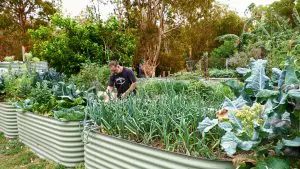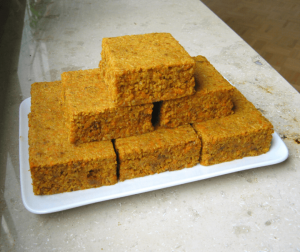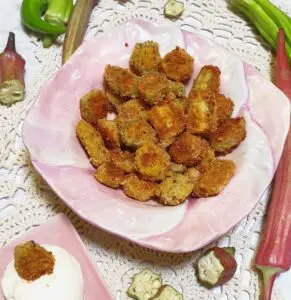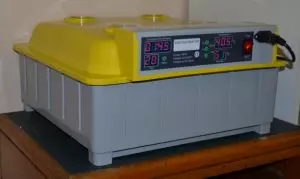I love to grow onions at home. Even though they’re cheap to buy, there is just something special about a freshly harvested, crisp onion. They are so versatile in the kitchen, being useful in everything from sauces, curries, soups to pickles and ferments. I grow them without any chemicals at all so they’re organic, which I think makes a big difference to the taste & freshness. You can grow fantastic onions too- just follow my 5 easy steps to onion success.

Prepare the Soil
Onions, like most veggies, prefer a fertile, free-draining soil. Without good drainage, onions can rot in the ground, especially if you live in a hot & humid climate. High-raised garden beds are great for providing exactly this, plus they’re easy to work with.
Like carrots, onions require some soil fertility but not too much, so don’t fertilise heavily before planting. I add a generous layer of compost to the bare soil but don’t fertilise at all during the growing season. If you don’t have enough home-made compost, you can use bagged commercial organic compost plus a bit of pelleted fertiliser. Alternatively, you could add some well-rotted chicken or horse manure, but only a small amount. Too much fertiliser (especially at the beginning) will result in bushy green tops and poor bulb development.

Sow seeds shallowly and cover them lightly with soil. Keep the soil moist until sprouting starts, then water as required. I like to sow a generous amount of onion seed to allow for poor germination. If you end up with too many plants, onion seedlings can easily be transplanted elsewhere in the garden.
I always add mulch on top because it reduces weeds. Weeds compete heavily with the slow-growing onion seedlings, plus the skinny baby onions are tedious to weed between.

Grow in the Right Weather
Onions need cool weather to grow successfully. You need to make sure you choose the right season or time of year to grow them in. I live in the subtropics, where we have a dry winter & a humid rainy summer, so I’m best to sow onions towards the end of autumn. This way I have them growing through winter and spring which are dry and cool. I then harvest them at the end of spring, before the humidity & summer rains begin. Humidity is essentially the enemy of onions: they can bolt to seed really early, fail to thrive, & the bulbs can rot and go slimy.
Onions are easier to grow in a cold climate. Seed can be sown through spring after the last frost, and the onions will grow through summer and be harvested when the weather cools again.
Choose Varieties that Suit Your Climate
Growing the right variety or type of onion is probably more important than growing them in the right season.
The growth habit of onions is largely influenced by daylight hours. The amount of daylight hours you have in your climates growing season is the most important factor in choosing the right variety for you. If you don’t get the right variety, onions may not bulb up or can fail completely.

There are short-day onions and long-day onions. Short-day onions are what I grow in the subtropics. As the name suggests, they are suited to a climate which has short daylight hours during the growing season. In the subtropics we have 11 hours or less of daylight per day in winter, so these are the types I grow. Short-day onions are also called early or fast-maturing. Long-day onions are suitable for cool climates where summer is the growing season. In these conditions, there will be 15-16 hours of daylight per day. Long-day onions are also known as late-maturing, and can be stored in the pantry for many months after harvest.
When buying onion seed, be sure to carefully check that the variety you choose is suitable for your growing climate. Having said that, I don’t want to put you off experimenting. After all, gardening is all about challenges and trying something new. Don’t be afraid to give something a go; you may not have brilliant results, but it’s always fun to try.
Bunching and cluster-type onions are just as useful and will grow right through the subtropical summer. Egyptian walking onions, spring onions and shallots have their own great flavour and are a perfect substitute when larger bulb types are difficult to grow.

Crowd Them In
This might seem counter-intuitive, because most onion experts will say you should thin your seedlings to a spacing of 25 cm (10″) apart. Such a spacing is thought to give the onions enough room to grow independently and therefore form larger bulbs. But this is not something that I do!
If you want to thin your seedlings and garden ‘by the book’, go for it- after all, it is a proven method. I thin mine to a small extent, but that’s mostly for early harvesting to use in the kitchen. However, crowd-growing is here as a top tip because it really does work. It allows you to maximise the return from your growing space, to suppress weeds and allows for earlier harvesting.

When to Harvest
You can harvest and eat onions at any time, especially when you have them crowded in and are thinning them out by harvesting as you go. It’s totally fine to eat onions with green tops. The idea that you need to bend or break the tops off onions to cure them before eating is a myth.
You can tell when onions are mature and ready to be harvested because the tops bend over naturally and start to die off. Some will go to seed at this time, usually the larger ones. I like to let a couple of plants go to seed, as this gives me seed for the following season.

Once harvested, lay your onions out in the sun for 3 or 4 days. You can use a drying rack or hang them on a fence or washing line. Let them die off fully so that the skins dry. This is called ‘curing’. After this, they’ll store well in the pantry or cupboard for up to several months.
To see the video version of our 5 easy steps to onion success, watch the youtube video below. Happy gardening- here’s to growing great onions!













